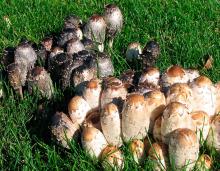Mushrooms
Media

Species Types
Scientific Name
Agaricus campestris
Description
The meadow mushroom has a smooth white to light grayish cap and pinkish brown gills. It's found in lawns and other grassy areas.
Media

Species Types
Scientific Name
Laccaria ochropurpurea
Description
The purple-gilled laccaria has a large, tannish lavender cap with thick, purplish gills and a stout stalk. It grows scattered or in groups in grassy areas and under hardwoods and conifers.
Media

Species Types
Scientific Name
Sarcoscypha occidentalis
Description
The stalked scarlet cup is, indeed, a tiny red cup on a tiny white stalk. It grows scattered on fallen wet sticks and branches in damp deciduous woods.
Media

Species Types
Scientific Name
Coprinus comatus
Description
The shaggy mane has a white, shaggy, cylindrical cap that turns black and inky. It often grows in large numbers along roadsides and in lawns and disturbed areas.
Media

Species Types
Scientific Name
Lycoperdon perlatum
Description
The gem-studded puffball is a white, rounded to turban-shaped ball, densely covered with spiny warts, developing a pore at the top. It grows on the ground in open woods, along roads, in waste areas.
Media

Species Types
Scientific Name
Phallus ravenelii
Description
Ravenel's stinkhorn is a long, whitish column with a greenish, smelly slime covering the top, and a whitish or pinkish cup around the base. It grows on wood debris, mulch, rotted stumps, and sawdust, and in deciduous woods.
Media

Species Types
Scientific Name
Tylopilus felleus
Description
The bitter bolete has a large, tannish brown cap with pinkish white pores and a webbed, tannish brown stalk. It grows singly or scattered on the ground in mixed woods.
Media

Species Types
Scientific Name
Amanita spp. (about 600 species, worldwide)
Description
This large group of mushrooms accounts for 90 percent of mushroom-related deaths, so every mushroom hunter should be familiar with amanitas. They contain one of the deadliest poisons found in nature!
Media

Species Types
Scientific Name
Amanita rubescens
Description
The blusher has a tan to reddish brown cap with pinkish brown patches and a ring on the stalk; the entire mushroom bruises reddish. It grows on the ground in oak woods and under white pines.
Media

Species Types
Scientific Name
Laccaria laccata
Description
The common laccaria has a small, brownish pink cap with a central depression; the gills and stalk are a pale pinkish brown. Grows scattered or in groups in poor or sandy soil in mixed woods.
See Also



Media

Species Types
Scientific Name
Monotropa hypopitys
Description
Pinesap is a plant that puts the "wild" in wildflower! It lacks chlorophyll, so its roots connect to fungi underground and absorb nutrients from the fungi.
Media

Species Types
Scientific Name
Cladophora, Pithophora, and Spirogyra spp., and others
Description
Filamentous green algae forms green, cottony masses that are free-floating or attached to rocks, debris, or other plants.
Media

Species Types
Scientific Name
Monotropa uniflora
Description
Indian pipe lacks chlorophyll, so it is white, not green. Below ground, its roots join with fungi that connect to tree roots. This plant, then, takes nourishment indirectly from the trees.
About Mushrooms in Missouri
Mushrooms are a lot like plants, but they lack chlorophyll and have to take nutrients from other materials. Mushrooms are neither plants nor animals. They are in a different kingdom — the fungi. Fungi include the familiar mushroom-forming species, plus the yeasts, molds, smuts, and rusts.
Always be cautious when eating edible mushrooms. Be absolutely sure of the ID, and only eat a small amount the first time you try it to avoid a reaction..





















